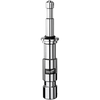Midterm Flashcards
(119 cards)
What is the difference between an Electrician and a Grip?
Electricians create light and Grips create shadows.
C-stand
Century stand: primarily used to position light modifiers
Junior Combo Stand

can be found as a double or triple riser, has a combination of a baby pin (5/8) and a junior pin (1 1/8) receptacle.
Large Gobo Head

aka “Lollipop” fits into the junior pin receptacle.
Light Modifiers

used to alter or control light (i.e. flags, silks, scrims, nets)
Flags

aka Solids or Cutters, create shadows/negative fill
Butterflies

large rags of solids, silks, and nets tied with a grip knot to metal frames. Large piece of material stretched onto metal frame.
(6’6’ to 10’x10’ are called butterflies)
Speed Rails

Rails made of aluminum, used to make custom-sized frames for rags (overheads) but can also be used to build rigs for camera and lighting mounts.
Apple Boxes

wooden bozes of varying sizes (pancake, quarter apple, half apple. full apple) with holes on each end.
Small Gobo Head
aka Grip Head, fits on to the baby pin of a C-stand
Baby Pin

5/8ths-inch pin on top of a baby stand.
Gaffer Grip Clamp
aka Alligator Clamp
Spring Clip

aka Grip Clip
Cardellini Clamp

One of the most versatile clamps is the Cardellini clamp. The unique angled jaw allows the clamp to grip to both flat as well as curved surfaces like speed rail.
Foam core Holder

aka duckbill, platypus, or quacker
What is a “doughnut”?

The rubber wheel on a dolly that rolls easily across flat surfaces.
What are “hot buttons”?

Skateboard wheels are used with a dolly track
Centipede

The “centipede” is a multi-wheel carriage for mounting a larger dolly with rubber wheels.
What are examples of mounting plates?

- Baby plate
- Junior plate
- Right angle baby plate
- Cheater plate
- Cheese plate multi-purpose
Dolly
is a platform with wheels, onto which a camera is mounted, in order to create movement in the shot, tracking shots.
Wedges and Cribbing

often used to level a dolly track, for a smooth dolly move.
Parts of the Camera
- Camera body
- Lens
- Viewfinder
- Matte box
- Battery
- Tripod
- Fluid Head
- Follow focus ring
Aspect Ratio
Refers to the height and width of a frame
Resolution
In digital cinema, resolution is represented by the horizontal pixel count (i.e. HD, 2K, 4K)
















